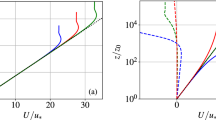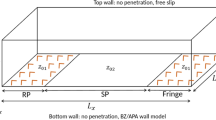Abstract
A simple analytical model is developed for the flow downwind of a step change of the aerodynamic roughness length in the atmospheric boundary layer. The region downwind of the roughness transition is assumed to be composed of two equilibrium layers, corresponding to the downwind and upwind conditions, and separated by a third, transition, layer. The key assumption in deriving the model is that the eddy viscosity in the transition region is composed of a linearly varying component and an augmentation, which is parabolic in the vertical coordinate. The model is fully predictive up to two parameters that need to be specified. The first parameter is the ratio between the equilibrium boundary-layer height and the internal boundary-layer height. The second parameter controls the degree of nonlinearity of the eddy viscosity augmentation. An empirical relation is developed for the first parameter, while a range of values (between 0.1 and 0.3) is recommended for the second. The model is tested with results from field observations, wind-tunnel experiments, and numerical simulations of the flow behind a sudden jump in surface roughness. These tests show that the flow field and surface stresses are predicted accurately for smooth-to-rough as well as rough-to-smooth transitions.














Similar content being viewed by others
References
Abkar M, Porté-Agel F (2012) A new boundary condition for large-eddy simulation of boundary-layer flow over surface roughness transitions. J Turbul 13:1–18
Anderson W (2020) Turbulent channel flow over heterogeneous roughness at oblique angles. J Fluid Mech 886:A15
Anderson W, Meneveau C (2011) Dynamic roughness model for large-eddy simulation of turbulent flow over multiscale fractal-like rough surfaces. J Fluid Mech 679:288–314
Anderson W, Barros JM, Christensen KT, Awasthi A (2015) Numerical and experimental study of mechanisms responsible for turbulent secondary flows in boundary layer flows over spanwise heterogeneous roughness. J Fluid Mech 768:316–347
Antonia RA, Luxton RE (1971) The response of a turbulent boundary layer to a step change in surface roughness Part 1. Smooth to rough. J Fluid Mech 48:721–761
Antonia RA, Luxton RE (1972) The response of a turbulent boundary layer to a step change in surface roughness Part 2. Rough to smooth. J Fluid Mech 53:737–757
Belcher SE, Harman IN, Finnigan JJ (2012) The wind in the willows: flows in forest canopies in complex Terrain. Annu Rev Fluid Mech 44:479–504
Benson J (2005) Boundary-layer response to a change in surface roughness. Master’s thesis, The University of Reading, Department of Meteorology
Bradley EF (1968) A micrometeorological study of velocity profiles and surface drag in the region modified by a change in surface roughness. Q J R Meteorol Soc 94:361–379
Calaf M, Meneveau C, Meyers J (2010) Large eddy simulation study of fully developed wind-turbine array boundary layers. Phys Fluids 22(015):110
Chamorro LP, Porté-Agel F (2009) Velocity and surface shear stress distributions begind a rough-to-smooth surface transition: a simple new model. Boundary-Layer Meteorol 130:29–41
Efros V, Korgstad PA (2011) Development of a turbulent boundary layer after a step from smooth to rough surface. Exp Fluids 51:1563–1575
Elliott WP (1958) The growth of the atmospheric internal boundary layer. Eos Trans AGU 39:1048–1054
Garratt JR (1994) Review: the atmospheric boundary layer. Earth Sci Rev 37:89–134
Ghaisas NS, Ghate AS, Lele SK (2017) Farm efficiency of large wind farms: Evaluation using large eddy simulation. In: Proceedings of Tenth International Symposium on Turbulence and Shear Flow Phenomena, TSFP10
Hanson RE, Ganapathisubramani B (2016) Development of turbulent boundary layers past a change in wall roughness. J Fluid Mech 795:494–523
Jimenez J (2004) Turbulent flows over rough walls. Annu Rev Fluid Mech 36:173–196
Li M, de Silva CM, Rouhi A, Baidya R, Chung D, Marusic I, Hutchins N (2019) Recovery of wall-shear stress to equilibrium flow conditions after a rough-to-smooth step change in turbulent boundary layers. J Fluid Mech 872:472–491
Luzzatto-Fegiz P, Caulfield CP (2018) Entrainment model for fully-developed wind farms: Effects of atmospheric stability and an ideal limit for wind farm performance. Phys Rev Fluids 3(093):802
Medjnoun T, Vanderwel C, Ganapathisubramani B (2020) Effects of heterogeneous surface geometry on secondary flows in turbulent boundary layers. J Fluid Mech 886:A31
Meyers J, Ganapathisubramani B, Cal RB (2019) On the decay of dispersive motions in the outer region of rough-wall boundary layers. J Fluid Mech 862:R5. https://doi.org/10.1017/jfm.2018.1019
Mulhearn PJ (1977) Relations between surface fluxes and mean profiles of velocity, temperature and concentration, downwind of a change in surface roughness. Q J R Meteorol Soc 103:785–802
Nemoto S (1972) Some Considerations on the Atmospheric Internal Boundary Layer over the Ground Surface. Pap Meteorol Geophys 23:121–134
Nishino T, Dunstan TD (2020) Two-scale momentum theory for time-dependent modelling of large wind farms. J Fluid Mech 894:A2. https://doi.org/10.1017/jfm.2020.252
Panofsky HA, Townsend AA (1964) Change of terrain roughness and the wind profile. Q J R Meteorol Soc 90:147–155
Placidi M, Ganapathisubramani B (2015) Effects of frontal and plan solidities on aerodynamic parameters and the roughness sublayer in turbulent boundary layers. J Fluid Mech 782:541–566
Plate EJ, Hidy GM (1967) Laboratory study of air flowing over a smooth surface onto small water waves. J Geophys Res 72:4627–4641
Rao KS, Wyngaard JC, Coté OR (1974) The structure of the two dimensional internal boundary layer over a sudden change of surface roughness. J Atmos Sci 31:738–746
Raupach MR, Antonia RA, Rajagopalan S (1991) Rough-wall turbulent boundary layers. Appl Mech Rev 44:1–25
Serafin S, Adler B, Cuxart J, De Wekker SFJ, Gohm A, Grisogono B, Kalthoff N, Kirshbaum DJ, Rotach MW, Schmidli J, Stiperski I, Vecenaj A, Zardi D (2018) Exchange processes in the atmospheric boundary layer over mountainous Terrain. Atmosphere. https://doi.org/10.3390/atmos9030102
Shir CC (1972) A numerical computation of air flow over a sudden change of surface roughness. J Atmos Sci 29:304–310
Sridhar A, Pullin DI, Cheng W (2017) Rough-wall turbulent boundary layers with constant skin friction. J Fluid Mech 818:26–45
Taylor PA (1969) On wind and shear stress profiles above a change in surface roughness. Q J R Meteorol Soc 95:77–91
Townsend AA (1965a) Self-preserving flow inside a turbulent boundary layer. J Fluid Mech 22:773–797
Townsend AA (1965b) The response of a turbulent boundary layer to abrupt change in surface conditions. J Fluid Mech 22:799–822
Author information
Authors and Affiliations
Corresponding author
Additional information
Publisher's Note
Springer Nature remains neutral with regard to jurisdictional claims in published maps and institutional affiliations.
Rights and permissions
About this article
Cite this article
Ghaisas, N.S. A Predictive Analytical Model for Surface Shear Stresses and Velocity Profiles Behind a Surface Roughness Jump. Boundary-Layer Meteorol 176, 349–368 (2020). https://doi.org/10.1007/s10546-020-00535-8
Received:
Accepted:
Published:
Issue Date:
DOI: https://doi.org/10.1007/s10546-020-00535-8




